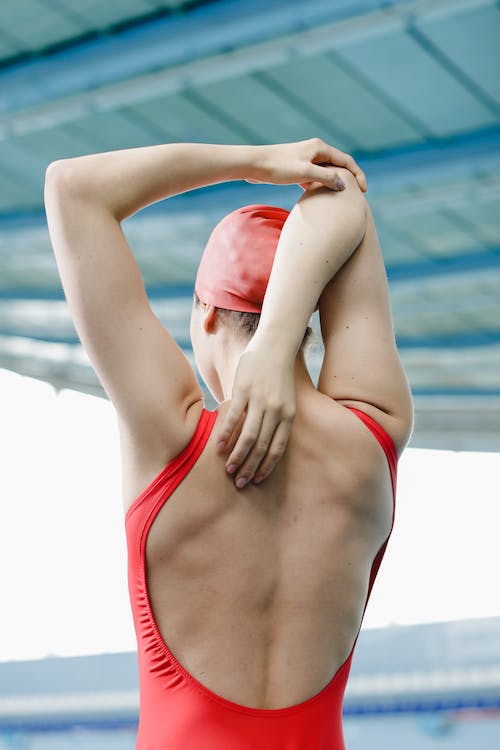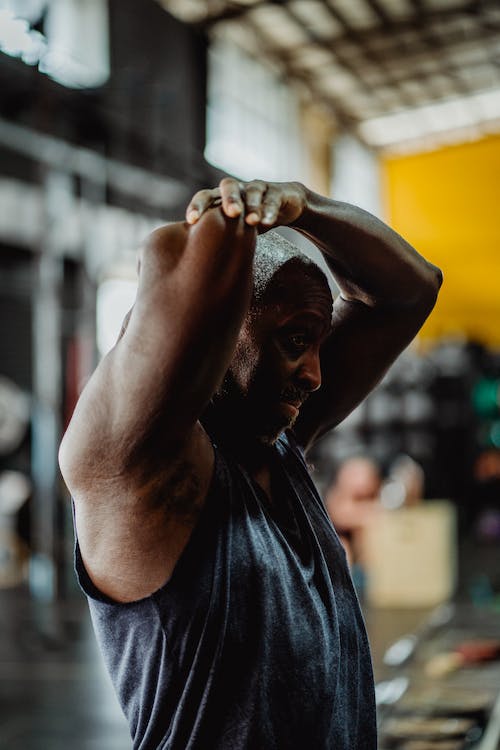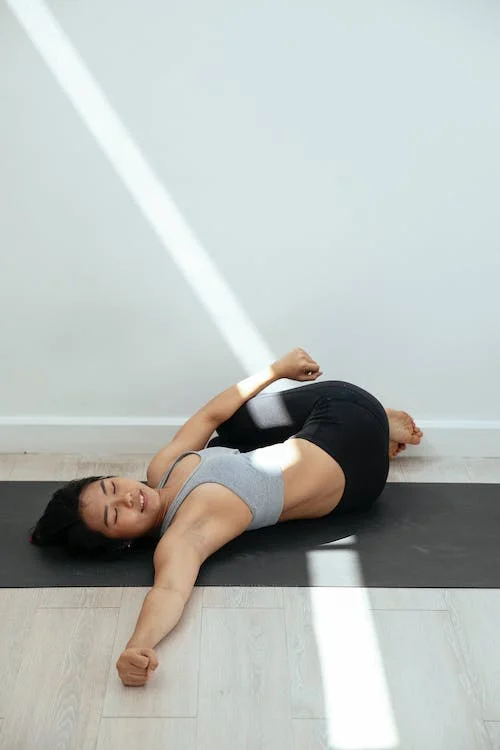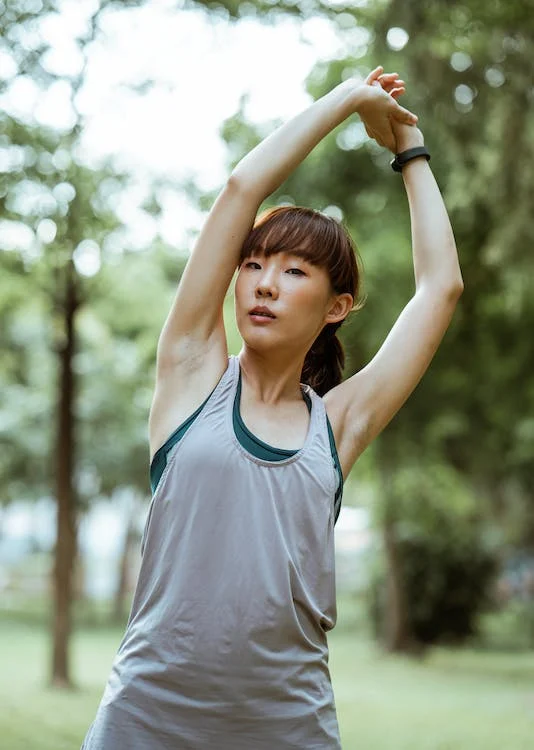Swimming, an interesting and healthy sport, offers numerous benefits to both your body and mind.
However, like any sport, swimming can come with its fair share of challenges, and one common issue swimmers often encounter is shoulder pain often called the swimmer’s shoulder.
Swimmer’s shoulder, medically known as shoulder impingement syndrome, is a painful condition caused by the repetitive overhead movements involved in swimming.
Swimmer’s shoulder is a common pain among swimmers, it occurs as a result of overuse and repetitive movements of the shoulder joint.
It can limit your range of movement in the water, hinder performance, and reduce the joy of being in the water. But fear not, because relief is within reach!
The good news is that there’s a solution within reach, and it doesn’t involve giving up your favorite activity.

Are you an avid swimmer who has experienced the discomfort of a swimmer’s shoulder? If so, you’re not alone.
In this blog post, we will introduce you to 6 essential swimmer’s shoulder stretching exercises designed specifically to relieve the swimmer’s shoulder pain.
These swimmer’s shoulder stretching exercises will not only help ease your discomfort but also contribute to improving your overall shoulder movement and preventing future injuries.
Why Swimmer’s Shoulder Stretching Exercises?
Stretching plays a crucial role in maintaining optimal shoulder function and preventing injuries.
By including these swimmer’s shoulder stretching exercises into your pre and post-swim routine, you can effectively warm up and cool down your muscles, increase blood flow, and improve your shoulder joint movement.
Additionally, regular stretching helps to lengthen tight muscles, release tension, and correct imbalances that may arise from repetitive swimming motions.
It’s important to note that while stretching can provide relief and prevent future discomfort, it’s always advisable to consult a healthcare professional or a qualified swim coach before starting any exercise regimen, especially if you have an existing shoulder condition.
In the upcoming sections, we will explore the six essential swimmer’s shoulder stretching exercises, providing step-by-step instructions, and tips to help you perform them correctly.
By adding these exercises to your swimming routine, you’ll be on your way to achieving pain-free and enjoyable swims!
So, let’s dive in and unlock the power of these stretches, ensuring that your shoulders remain strong, flexible, and ready for the next stroke!
-
Overhead Arm Stretch
The overhead arm stretch specifically targets the muscles and tendons associated with the swimmer’s shoulder, boosting flexibility, reducing pain, and improving overall shoulder health.

By including this particular swimmer’s shoulder stretching exercise into your pre and post-swim routine, you can effectively warm up and cool down your muscles, increase blood flow, and prevent potential injuries.
Step-by-Step Instructions to Practice the Overhead Arm Stretch:
- Stand tall with your feet shoulder-width apart.
- Extend your right arm straight above your head, keeping it close to your ear.
- Bend your right elbow, allowing your right hand to reach towards your left shoulder blade.
- Use your left hand to gently grasp your right elbow.
- Apply gentle pressure with your left hand, pulling your right elbow towards your left shoulder blade.
- Hold this position for 15 to 30 seconds while maintaining a relaxed breathing pattern.
- Release the stretch and repeat the same steps with your left arm.
Tips to Enhance the Effectiveness of the Overhead Arm Stretch
To make the most of your overhead arm stretch and optimize its effectiveness, consider the following tips:
- Start with a gentle warm-up: Before performing the stretch, warm up your shoulder muscles with light shoulder rotations and arm swings. This helps prepare your muscles for stretching and reduces the risk of injury.
- Focus on proper alignment: Maintain good posture throughout the stretch, keeping your spine straight and your shoulders relaxed. Avoid arching your back or shrugging your shoulders.
- Gradually increase the stretch: Start with a comfortable range of motion and gradually increase the intensity of the stretch over time. Listen to your body and avoid pushing yourself too hard.
- Breathe deeply and relax: While performing the overhead arm stretch, take slow, deep breaths to relax your muscles and enhance the stretch. Avoid holding your breath, as it can create tension in your muscles.
Benefits of the Overhead Arm Stretch and the Targeted Muscles
The overhead arm stretch offers numerous benefits for swimmers suffering from shoulder pain:
- Increased shoulder flexibility: This stretch helps improve the flexibility and range of motion in your shoulder joint, allowing for smoother swimming movements.
- Relieved muscle tension: By stretching the muscles and tendons involved in swimming, the overhead arm stretch helps ease tightness and reduces muscle tension, providing relief from the swimmer’s shoulder pain.
- Improved posture: Regularly performing this stretch can contribute to better overall posture, as it targets the muscles that support proper shoulder alignment.
- Enhanced recovery: The overhead arm stretch promotes blood circulation, which aids in the recovery process by supplying nutrients and oxygen to the shoulder muscles.
The targeted muscles during the overhead arm stretch include:
- Deltoids: These muscles form the rounded contour of your shoulders and are responsible for lifting your arms overhead.
- Rotator cuff muscles: These muscles help stabilize and rotate the shoulder joint, ensuring smooth movement during swimming.
- Trapezius: This muscle spans the upper back and neck area and assists in shoulder movement and posture.
-
External Shoulder Rotation Stretch
The external shoulder rotation stretch focuses on the rotator cuff muscles, which are responsible for stabilizing and supporting the shoulder joint during swimming.

By performing this stretch regularly, you can improve the flexibility and mobility of your shoulders, reduce tension, and find relief from the swimmer’s shoulder pain.
Step-by-Step Instructions to Practice the External Shoulder Rotation Stretch:
- Stand tall with your feet shoulder-width apart.
- Hold a resistance band in front of you with both hands, gripping it shoulder-width apart.
- Position your elbows at a 90-degree angle, tucked in close to your sides.
- Keep your shoulders relaxed and your core engaged throughout the stretch.
- Slowly rotate your forearms outward, away from your body, while maintaining the 90-degree angle at your elbows.
- Continue the rotation until you feel a gentle stretch in your shoulders and chest.
- Hold the stretch for 15 to 30 seconds, while maintaining a relaxed breathing pattern.
- Slowly return to the starting position and repeat the stretch for the desired number of repetitions.
Tips to Enhance the Effectiveness of the External Shoulder Rotation Stretch
To optimize the benefits of the External Shoulder Rotation Stretch and ensure proper execution, consider the following tips:
- Choose an appropriate resistance band: Select a resistance band that provides a moderate level of tension. Avoid using a band that is too tight or too loose, as it may compromise the effectiveness of the stretch.
- Focus on controlled movements: Perform the rotation movement slowly and with control. Avoid any jerky or sudden movements that could lead to strain or injury.
- Gradually increase the resistance: As you become more comfortable with the exercise, you can progress to a higher resistance band to further challenge your muscles and enhance the stretch.
- Pay attention to posture: Maintain good posture throughout the stretch, keeping your spine straight and your shoulders relaxed. Avoid hunching forward or arching your back.
Benefits of the External Shoulder Rotation Stretch and the Targeted Muscles
The External Shoulder Rotation Stretch offers several benefits for swimmers looking to relieve shoulder pain:
- Improved shoulder flexibility: This stretch targets the muscles responsible for shoulder rotation and external rotation, promoting an increased range of motion and flexibility.
- Reduced muscle tension: By stretching the muscles and tendons involved in swimming, the External Shoulder Rotation Stretch helps alleviate tightness and reduces muscle tension, providing relief from the swimmer’s shoulder pain.
- Enhanced muscle balance: Regularly performing this stretch can help correct muscle imbalances that may develop due to repetitive swimming movements, ensuring balanced shoulder strength and stability.
- Injury prevention: The stretch engages the rotator cuff muscles, which play a crucial role in stabilizing the shoulder joint. Strengthening and stretching these muscles can help prevent shoulder injuries during swimming.
The targeted muscles during the External Shoulder Rotation Stretch include:
- Infraspinatus: Located in the back of the shoulder, this muscle assists in the external rotation of the arm and contributes to shoulder stability.
- Teres Minor: Situated beneath the infraspinatus, this muscle also aids in external rotation and shoulder stability.
- Posterior Deltoid: This muscle forms the rear portion of the shoulder and assists in shoulder extension and external rotation.
READ ALSO: 10 Secrets to Achieve A Great Female Swimmer Body
-
The Doorway Stretch
The Doorway Stretch targets the muscles and tendons associated with the swimmer’s shoulder, helping to relieve pain, improve flexibility, and restore proper shoulder function.

By adding this stretch to your pre and post-swim routine, you can effectively warm up your muscles, increase blood flow, and reduce the risk of injury.
Step-by-Step Instructions to Practice the Doorway Stretch:
- Stand facing an open doorway with your feet hip-width apart.
- Raise both arms and place your forearms against the doorframe, with your elbows at a 90-degree angle.
- Take a small step forward with one foot, creating a gentle stretch in your chest and shoulders.
- Keep your back straight and gently lean forward into the stretch until you feel a comfortable tension.
- Hold the stretch for 15 to 30 seconds while maintaining a relaxed breathing pattern.
- Slowly step back to release the stretch and repeat on the other side.
Tips to Enhance the Effectiveness of the Doorway Stretch
To maximize the benefits of the Doorway Stretch and perform it correctly, consider the following tips:
-
Start with a comfortable distance: Begin by standing at a distance from the doorframe that allows your forearms to rest against it with your elbows at a 90-degree angle.
As you become more flexible, you can gradually increase the stretch by stepping farther away from the doorframe. -
Engage your core and maintain proper posture: Throughout the stretch, engage your core muscles and keep your back straight.
Avoid arching your lower back or slouching forward, as it can compromise the effectiveness of the stretch.
-
Control the intensity: Control the depth of the stretch to avoid overstretching or causing pain.
You should feel a gentle pull in your chest and shoulders, but it should not be uncomfortable or painful. Gradually increase the intensity as your flexibility improves. - Relax your neck and breathe deeply: Ensure that your neck and facial muscles are relaxed during the stretch. Take slow, deep breaths to promote relaxation and enhance the effectiveness of the stretch.
Benefits of the Doorway Stretch and the Targeted Muscles
The Doorway Stretch offers several benefits that can help relieve swimmer’s shoulder pain:
- Increased shoulder flexibility: This stretch targets the chest muscles (pectoralis major and minor) and the anterior deltoids, improving their flexibility and allowing for a greater range of motion in the shoulders.
- Reduced muscle tension: By stretching the chest and shoulder muscles, the Doorway Stretch helps relieve tightness and reduces muscle tension, providing relief for the swimmer’s shoulder pain.
- Improved posture: Regularly performing this stretch can help correct rounded shoulders and improve overall posture by opening up the chest muscles and releasing tension in the shoulders.
- Enhanced shoulder joint stability: The stretch engages the rotator cuff muscles, promoting their strength and stability. This can help prevent shoulder injuries and improve overall shoulder joint function during swimming.
The targeted muscles during the Doorway Stretch include:
- Pectoralis major and minor: These muscles are located in the chest and play a significant role in shoulder movement and stability.
- Anterior deltoids: These muscles are responsible for lifting the arms forward and are frequently engaged during swimming strokes.
-
Cross-Body Shoulder Stretch
To relieve the swimmer’s shoulder pain, one of the effective stretches that can provide significant relief is the Cross-Body Shoulder Stretch.

The Cross-Body Shoulder Stretch also targets the muscles and tendons associated with the swimmer’s shoulder, promoting flexibility, reducing pain, and restoring optimal shoulder function.
By including this stretch in your pre and post-swim routine, you can warm up your muscles, increase blood flow, and minimize the risk of injury.
Step-by-Step Instructions to Practice the Cross-Body Shoulder Stretch:
- Stand tall with your feet, shoulder-width apart.
- Extend your right arm straight across your chest, reaching towards the left side.
- Use your left hand to gently pull your right arm closer to your chest, feeling a stretch in your right shoulder and upper back.
- Keep your shoulders relaxed and maintain a straight posture throughout the stretch.
- Hold the stretch for 15 to 30 seconds, breathing deeply and maintaining a relaxed state.
- Release the stretch and repeat the same steps with your left arm, reaching across your chest towards the right side.
Tips to Enhance the Effectiveness of the Cross-Body Shoulder Stretch
To optimize the benefits of the Cross-Body Shoulder Stretch and perform it correctly, consider the following tips:
-
Start with a gentle warm-up: Before performing the stretch, warm up your shoulder muscles with light shoulder rotations and arm swings.
This helps prepare your muscles for stretching and reduces the risk of injury. -
Gradually increase the stretch: Begin with a comfortable range of motion and gradually increase the intensity of the stretch over time.
Listen to your body and avoid pushing yourself too hard. The goal is to feel a gentle stretch, not pain. -
Maintain proper posture: Keep your spine straight and your shoulders relaxed throughout the stretch. Avoid rounding your back or hunching your shoulders forward.
Maintaining good posture allows for optimal alignment and maximum effectiveness of the stretch. - Breathe deeply and relax: Focus on deep breathing during the stretch to promote relaxation and help release tension in the muscles. Inhale deeply through your nose, expand your belly, and exhale slowly through your mouth.
Benefits of the Cross-Body Shoulder Stretch and the Targeted Muscles
The Cross-Body Shoulder Stretch offers several benefits for swimmers seeking relief from shoulder pain:
-
Increased shoulder flexibility: This stretch targets the muscles responsible for shoulder internal rotation, including the posterior deltoid and infraspinatus.
Regularly performing the Cross-Body Shoulder Stretch can improve shoulder flexibility and range of motion. - Reduced muscle tension: By stretching the muscles and tendons involved in swimming, this stretch helps alleviate tightness and reduces muscle tension in the shoulders and upper back, providing relief for the swimmer’s shoulder pain.
-
Improved muscle balance: Swimming primarily engages the muscles involved in shoulder internal rotation.
The Cross-Body Shoulder Stretch helps restore muscle balance by targeting the muscles responsible for shoulder external rotation, promoting balanced strength and stability. -
Enhanced posture: Regularly including this stretch in your routine can help improve posture by counteracting the forward shoulder position often seen in swimmers.
Opening up the shoulders and upper back through the Cross-Body Shoulder Stretch can lead to improved posture both in and out of the water.
The targeted muscles during the Cross-Body Shoulder Stretch include:
- Posterior deltoid: Located at the back of the shoulder, this muscle aids in shoulder extension, external rotation, and overall shoulder stability.
- Infraspinatus: Situated beneath the deltoid, this muscle is responsible for the external rotation of the shoulder joint and plays a crucial role in shoulder stability.
-
The Sleeper Stretch
The Sleeper Stretch focuses on the muscles and tendons linked to the swimmer’s shoulder, helping to enhance flexibility, alleviate pain, and restore optimal shoulder function.

By incorporating this stretch into your pre and post-swim routine, you can effectively warm up your muscles, improve blood flow, and reduce the chance of injury.
Step-by-Step Instructions to Practice the Sleeper Stretch:
- Lie on your side with the shoulder you want to stretch facing upward.
- Bend your elbow at a 90-degree angle, with your forearm resting on the surface in front of you.
- Use your opposite hand to gently apply downward pressure on your forearm, pushing your hand towards the surface.
- Feel the stretch in the back of your shoulder and hold it for 15 to 30 seconds
- Release the stretch and switch to the other side, repeating the same steps.
Tips to Enhance the Effectiveness of the Sleeper Stretch
To maximize the benefits of the Sleeper Stretch and perform it correctly, consider the following tips:
-
Start with a proper warm-up: Before performing the stretch, warm up your shoulder muscles with gentle shoulder rotations and arm swings.
This helps prepare your muscles for stretching and reduces the risk of injury. -
Adjust the angle of your arm: Experiment with the angle at which your forearm rests on the surface. Find a position that allows you to feel a gentle stretch in the back of your shoulder without any pain.
Every individual’s shoulder mobility may vary, so listen to your body and make the necessary adjustments.
-
Control the pressure: Apply downward pressure on your forearm gradually and gently. Avoid using excessive force or pushing through any pain.
The goal is to feel a comfortable stretch, not to overstretch or strain the shoulder joint.
Benefits of the Sleeper Stretch and the Targeted Muscles
The Sleeper Stretch offers several benefits for swimmers seeking relief from shoulder pain:
-
Increased shoulder flexibility: This stretch primarily targets the muscles responsible for shoulder internal rotation, such as the posterior cuff muscles and the subscapularis.
Regularly performing the Sleeper Stretch can improve shoulder flexibility and range of motion. -
Reduced muscle tightness: The repetitive motions of swimming can cause tightness and imbalances in the shoulder muscles.
The Sleeper Stretch helps relieve this tightness, releasing tension in the back of the shoulder and promoting better muscle balance. -
Improved shoulder mechanics: By stretching the muscles involved in internal rotation, the Sleeper Stretch helps maintain proper shoulder mechanics during swimming. This can lead to more efficient and pain-free strokes in the water.
-
Enhanced shoulder stability: The muscles targeted by the Sleeper Stretch, including the rotator cuff muscles, play a crucial role in shoulder stability.
Strengthening and stretching these muscles can improve overall shoulder stability and reduce the risk of injuries.
The targeted muscles during the Sleeper Stretch include:
- Subscapularis: Located deep in the shoulder, the subscapularis muscle is responsible for the internal rotation of the shoulder joint.
- Posterior cuff muscles: This group of muscles includes the infraspinatus and teres minor, which aid in external rotation and shoulder stability.
READ ALSO: Hilarious Jokes About Swimmers That Will Make You Laugh
-
Arm Circles Stretch
One highly effective stretch for swimmer’s shoulder pain relief is the Arm Circles Stretch.
The Arm Circles Stretch specifically targets the muscles and tendons associated with the swimmer’s shoulder, providing numerous benefits.

Adding the Arm Circles Stretch into your pre-swim warm-up and post-swim cool-down can help you embrace fluidity and ease in your shoulders.
Step-by-Step Instructions to Practice the Arm Circles Stretch:
- Stand tall with your feet shoulder-width apart and your arms extended straight out to the sides, parallel to the ground.
- Start making small circular motions with your arms, gradually increasing the size of the circles.
- Continue the circular motion for 10-15 seconds, focusing on maintaining fluidity and control.
- Reverse the direction of the circles, gradually decreasing the size until you return to the starting position.
- Repeat the arm circles for the desired number of repetitions.
Tips to Enhance the Effectiveness of the Arm Circles Stretch
To maximize the benefits of the Arm Circles Stretch, consider the following tips:
- Maintain proper posture: Stand tall with your shoulders relaxed and your core engaged. Avoid hunching or shrugging your shoulders during the exercise.
- Control the movement: Perform the arm circles with control and fluidity, avoiding any jerky or sudden motions. Focus on the quality of the movement rather than speed.
- Gradually increase intensity: Start with small circles and gradually increase the size as your muscles warm up. Listen to your body and avoid overstretching or pushing beyond your comfort zone.
- Incorporate deep breathing: Coordinate your breathing with the arm circles by taking deep breaths in and out. This can help promote relaxation and enhance the overall stretching experience.
Benefits of the Arm Circles Stretch and the Targeted Muscles
The Arm Circles Stretch offers several benefits for swimmers seeking relief from shoulder pain:
- Improved shoulder mobility: The circular motion engages the muscles responsible for shoulder abduction and rotation, including the deltoids and rotator cuff muscles. Regularly practicing the Arm Circles Stretch can improve shoulder mobility and range of motion.
- Reduced muscle tightness: By actively moving the arms in circular motions, the Arm Circles Stretch helps release tension in the shoulder muscles, reducing muscle tightness and promoting better muscle balance.
- Enhanced blood flow and warm-up: Engaging in the Arm Circles Stretch before swimming increases blood flow to the shoulder area, helping to warm up the muscles and prepare them for the demands of swimming.
-
Shoulder joint stability: The muscles targeted by the Arm Circles Stretch, such as the rotator cuff muscles and deltoids, play a crucial role in shoulder stability.
Strengthening and stretching these muscles can improve overall shoulder joint stability and reduce the risk of injuries.
The targeted muscles during the Arm Circles Stretch include:
- Deltoid muscles: The deltoids are responsible for shoulder abduction and flexion, and they play a significant role in the movement and stability of the shoulder joint.
- Rotator cuff muscles: These muscles, including the supraspinatus, infraspinatus, teres minor, and subscapularis, contribute to shoulder rotation and stability.
How long is the Swimmer’s Shoulder Recovery Time?
Well, the recovery time can vary from person to person and depends on several factors, including the severity of the injury, the individual’s commitment to rehabilitation, and following professional guidance.
On average, mild cases of swimmer’s shoulder may heal in a few weeks (4 to 6 weeks), while more severe cases could take several months (3 to 6 months).
Here’s a general breakdown of the recovery stages:
- Rest and Pain Management (2-6 weeks): Initially, you will need to rest your shoulder to allow the inflammation to subside. Ice, anti-inflammatory medications, and physical therapy can help manage pain and reduce swelling.
- Physical Therapy (6-10 weeks): In severe cases, a crucial aspect of recovery is working with a physical therapist that specializes in sports injuries. They will design a rehabilitation program to improve shoulder strength and flexibility gradually.
- Gradual Return to Swimming (varies): The timeline for returning to swimming varies depending on your progress. It’s essential not to rush this step to avoid getting reinjured.
- Preventative Measures (ongoing): Once you are back in the water, maintaining a routine of shoulder-strengthening exercises and proper stroke technique is essential to prevent future occurrences.
Tips for a Speedy Recovery
- Follow Medical Advice: Always listen to your healthcare provider or physical therapist’s recommendations. They are experts and will guide you through your recovery journey.
- Rest Properly: Give your shoulder the rest it needs. Avoid activities that worsen the pain, and ensure you get enough sleep for optimal healing.
- Ice and Heat Therapy: Applying ice packs to the affected area can help reduce inflammation, while heat therapy can alleviate muscle tension.
- Strengthening Exercises: Regularly perform exercises prescribed by your physical therapist to regain strength and flexibility in your shoulder.
- Proper Swimming Technique: Consult a swim coach to ensure your strokes are biomechanically sound, reducing the risk of future injuries.
READ ALSO: Does Swimming Increase Height?
Conclusion
In conclusion, including a regular stretching routine in your swimming routine can be instrumental in relieving the swimmer’s shoulder pain and preventing future injuries.
The six essential shoulder stretching exercises outlined in this article target the key muscles and joints involved in swimming, providing relief and promoting flexibility.
By regularly performing these stretches, you can improve the range of motion in your shoulders, reduce muscle imbalances, and enhance your overall swimming performance.

Remember, prevention is key, and taking proactive steps to maintain shoulder health is essential for swimmers of all levels.
However, it’s important to approach these exercises with caution and listen to your body.
If you experience any pain or discomfort during the stretches, it’s advisable to consult with a healthcare professional or a qualified swimming coach.
They can assess your technique, provide personalized guidance, and offer additional exercises or modifications tailored to your specific needs.
Make sure to prioritize consistency and gradually increase the intensity and duration of your stretches over time.
Remember, stretching alone cannot address all the underlying factors that contribute to swimmer’s shoulder pain.
It is crucial to maintain proper swimming technique, gradually increase training loads, and listen to your body’s signals to avoid overuse injuries.
So, let’s prioritize shoulder health and add these six essential shoulder stretching exercises to your swimming routine.
Your shoulders will thank you, and you’ll be on your way to a pain-free and enjoyable swimming experience. Happy swimming!
Note: Please note that the content provided in this article is only for informational purposes and is not intended to serve as a substitute for professional medical advice.
Always consult with a healthcare professional before starting any new exercise program or if you have any concerns about your shoulder health.
